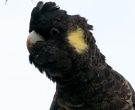Content |
|---|
Description
55 to 65 cm.. length and a weight of up to 900 g..
The Yellow-tailed black cockatoo (Calyptorhynchus funereus) stands out clearly by its plumage mostly black, patch yellow in cheek and yellow panels in tail.
The body feathers They are lined with yellow giving it a scalloped appearance. It has a crest short and moving on top of her head.
The female It has a yellow stain on the cheek more defined and larger than the male, Bello to singr pale gray (Pink in males)
The juveniles has plumage duller overall.
The bill top of immature male black obscures two years old, While the lower peak black four years.
- Sound of the Yellow-tailed black cockatoo.
Description 3 subspecies
-
Calyptorhynchus funereus funereus
(Shaw, 1794) – Nominal. Larger and tail longer dark mottled.
-
Calyptorhynchus funereus whiteae
(Mathews, 1912)
-
Calyptorhynchus funereus xanthanotus
(Gould, 1838) – Smaller size, tail shorter dark mottled.
Habitat:
Variety of types habitats, including forests of eucalyptus, heaths, subalpine areas, pine plantations and occasionally in urban areas.
They are often seen flying in pairs or trios formed by a pair and their young., although outside the breeding season they can join in more numerous flocks.
Reproduction:
have a long breeding season, that varies throughout its range, although Tasmania in general it is from October to February. Both sexes construct the nest in holes of mature trees, high, generally eucalyptus. Fill the hole of wood chips. The same tree can be used for many years.
One or two eggs form a clutch. Only the female incubates the eggs, While the male supplies the food. Both parents help rear the chicks, Although usually only one chick survives. The chicks leave the nest about three months after hatching and remain in the company of their parents until the next breeding season.
Food:
Seeds native trees, terrestrial plants and pine cones. Some insects also part of their diet. Unlike other cockatoos, a significant proportion of the diet up wood borers worms. The bird put his ear against the surface of dead trees to hear the sound of worms. If a worm is detected, the bird will use their powerful beaks to pull pieces of the tree until you get to the meal, often leaving a pile of wood chips at the base of the tree. These scars on dead trees are a common sight in the forests of Tasmania.
Distribution:
Size of its range (breeding/resident ): 2.700.000 km2
It is up to the 2000 meters throughout Southeast Australia, from South Eyre Peninsula to the east-central Queensland.
Your number is declining in parts of its range due to habitat fragmentation and loss of large trees used for breeding.
In Tasmania is common and nomadic. They can be seen in many parts of the state and in the larger islands Bass Strait.
Distribution 3 subspecies
-
Calyptorhynchus funereus funereus
(Shaw, 1794) – Nominal. The East of Victoria, New South Wales and Queensland.
-
Calyptorhynchus funereus whiteae
(Mathews, 1912) – South of Australia (including Eyre Peninsula and Kangaroo Island) and western Victoria.
-
Calyptorhynchus funereus xanthanotus
(Gould, 1838) – In Tasmania only.
Conservation:
State of conservation ⓘ |
||
|---|---|---|
 Minor Concern ⓘ
(UICN)ⓘ
Minor Concern ⓘ
(UICN)ⓘ
| ||
• Current category of the Red List of the UICN: Least concern.
• Population trend: Stable.
This species has a very large range, and therefore not approaching the threshold of vulnerable. Not threatened worldwide. CITES II. As with most other cockatoos, its long-term existence depends on the continued availability of hollow trees for nesting,
The population is estimated at at least 25.000 birds.
The population trend appears to be stable.
"Yellow-tailed black cockatoo" in captivity:
In the poultry industry this species is extremely rare and expensive. In Australia It has attained breed in captivity.
Like all cockatoos, they come to live over 40 years.
Alternative names:
– Yellow-tailed Black-Cockatoo, Black Cockatoo, Common Black-Cockatoo, Funeral Cockatoo (English).
– Cacatoès funèbre, Cacatoès noir à queue jaune (French).
– Gelbohrkakadu, Gelbschwanz-Rußkakadu, Rußkakadu (German).
– Cacatua-negra-de-cauda-amarela (Portuguese).
– Cacatúa Fúnebre Coliamarilla, Cacatúa Fúnebre de Cola Amarilla (español).

scientific classification:
– Order: Psittaciformes
– Family: Cacatuidae
– Genus: Calyptorhynchus
– Scientific name: Calyptorhynchus funereus
– Citation: (Shaw, 1794)
– Protonimo: Psittacus funereus
Images Cockatoo Fúnebre Coliamarilla:
Sources:
– www.parks.tas.gov.au
– avibase
– Birdlife
– Photos: David Cook
– Sounds: Nigel Jackett





